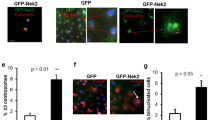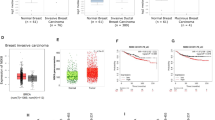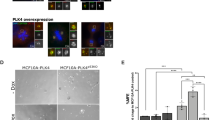Abstract
Breast cancer is the most common solid tumor and the second most common cause of death in women. Despite a large body of literature and progress in breast cancer research, many molecular aspects of this complex disease are still poorly understood, hindering the design of specific and effective therapeutic strategies. To identify the molecules important in breast cancer progression and metastasis, we tested the in vivo effects of inhibiting the functions of various kinases and genes involved in the regulation/modulation of the cytoskeleton by downregulating them in mouse PyMT mammary tumor cells and human breast cancer cell lines. These kinases and cytoskeletal regulators were selected based on their prognostic values for breast cancer patient survival. PyMT tumor cells, in which a selected gene was stably knocked down were injected into the tail veins of mice, and the formation of tumors in the lungs was monitored. One of the several genes found to be important for tumor growth in the lungs was NIMA-related kinases 2 (Nek2), a cell cycle-related protein kinase. Furthermore, Nek2 was also important for tumor growth in the mammary fat pad. In various human breast cancer cell lines, Nek2 knockdown induced aneuploidy and cell cycle arrest that led to cell death. Significantly, the breast cancer cell line most sensitive to Nek2 depletion was of the triple negative breast cancer subtype. Our data indicate that Nek2 has a pivotal role in breast cancer growth at primary and secondary sites, and thus may be an attractive and novel therapeutic target for this disease.
This is a preview of subscription content, access via your institution
Access options
Subscribe to this journal
Receive 50 print issues and online access
$259.00 per year
only $5.18 per issue
Buy this article
- Purchase on Springer Link
- Instant access to full article PDF
Prices may be subject to local taxes which are calculated during checkout






Similar content being viewed by others
References
Siegel R, Ward E, Brawley O, Jemal A . Cancer statistics, 2011: the impact of eliminating socioeconomic and racial disparities on premature cancer deaths. CA Cancer J Clin 2011; 61: 212–236.
Gennari A, Conte P, Rosso R, Orlandini C, Bruzzi P . Survival of metastatic breast carcinoma patients over a 20-year period: a retrospective analysis based on individual patient data from six consecutive studies. Cancer 2005; 104: 1742–1750.
Chia SK, Speers CH, D’Yachkova Y, Kang A, Malfair-Taylor S, Barnett J et al. The impact of new chemotherapeutic and hormone agents on survival in a population-based cohort of women with metastatic breast cancer. Cancer 2007; 110: 973–979.
Nandini D, Smith BR, Leyland-Jones B . Targeting basal-like breast cancers. Curr Drug Targets 2012; 13: 1510–1524.
Reddy KB . Triple-negative breast cancers: an updated review on treatment options. Curr Oncol 2011; 18: e173–e179.
Yunokawa M, Koizumi F, Kitamura Y, Katanasaka Y, Okamoto N, Kodaira M et al. Efficacy of everolimus, a novel mTOR inhibitor, against basal-like triple-negative breast cancer cells. Cancer Sci 2012; 103: 1665–1671.
Shibata H, Miuma S, Saldivar JC, Huebner K . Response of subtype-specific human breast cancer-derived cells to poly(ADP-ribose) polymerase and checkpoint kinase 1 inhibition. Cancer Sci 2011; 102: 1882–1888.
Tryfonopoulos D, Walsh S, Collins DM, Flanagan L, Quinn C, Corkery B et al. Src: a potential target for the treatment of triple-negative breast cancer. Ann Oncol 2011; 22: 2234–2240.
Loddo M, Kingsbury SR, Rashid M, Proctor I, Holt C, Young J et al. Cell-cycle-phase progression analysis identifies unique phenotypes of major prognostic and predictive significance in breast cancer. Br J Cancer 2009; 100: 959–970.
Hu K, Law JH, Fotovati A, Dunn SE . Small interfering RNA library screen identified polo-like kinase-1 (PLK1) as a potential therapeutic target for breast cancer that uniquely eliminates tumor-initiating cells. Breast Cancer Res 2012; 14: R22.
Romanelli A, Clark A, Assayag F, Chateau-Joubert S, Poupon MF, Servely JL et al. Inhibiting Aurora kinases reduces tumor growth and suppresses tumor recurrence after chemotherapy in patient-derived triple-negative breast cancer xenografts. Mol Cancer Ther 2012; 11: 2693–2703.
Fiskus W, Hembruff SL, Rao R, Sharma P, Balusu R, Venkannagari S et al. Co-treatment with vorinostat synergistically enhances activity of Aurora kinase inhibitor against human breast cancer cells. Breast Cancer Res Treat 2012; 135: 433–444.
Fry AM, Schultz SJ, Bartek J, Nigg EA . Substrate specificity and cell cycle regulation of the Nek2 protein kinase, a potential human homolog of the mitotic regulator NIMA of Aspergillus nidulans. J Biol Chem 1995; 270: 12899–12905.
Fry AM, O’Regan L, Sabir SR, Bayliss R . Cell cycle regulation by the NEK family of protein kinases. J Cell Sci 2012; 125 (Pt 19): 4423–4433.
Fry AM, Meraldi P, Nigg EA . A centrosomal function for the human Nek2 protein kinase, a member of the NIMA family of cell cycle regulators. EMBO J 1998; 17: 470–481.
Ha Kim Y, Yeol Choi J, Jeong Y, Wolgemuth DJ, Rhee K . Nek2 localizes to multiple sites in mitotic cells, suggesting its involvement in multiple cellular functions during the cell cycle. Biochem Biophys Res Commun 2002; 290: 730–736.
Fry AM . The Nek2 protein kinase: a novel regulator of centrosome structure. Oncogene 2002; 21: 6184–6194.
Hayward DG, Clarke RB, Faragher AJ, Pillai MR, Hagan IM, Fry AM . The centrosomal kinase Nek2 displays elevated levels of protein expression in human breast cancer. Cancer Res 2004; 64: 7370–7376.
Richardson AL, Wang ZC, De Nicolo A, Lu X, Brown M, Miron A et al. X chromosomal abnormalities in basal-like human breast cancer. Cancer Cell 2006; 9: 121–132.
Komatsu M, Yoshimaru T, Matsuo T, Kiyotani K, Miyoshi Y, Tanahashi T et al. Molecular features of triple negative breast cancer cells by genome-wide gene expression profiling analysis. Int J Oncol 2013; 42: 478–506.
Wang S, Li W, Liu N, Zhang F, Liu H, Liu F et al. Nek2A contributes to tumorigenic growth and possibly functions as potential therapeutic target for human breast cancer. J Cell Biochem 2012; 113: 1904–1914.
Innocenti P, Cheung KM, Solanki S, Mas-Droux C, Rowan F, Yeoh S et al. Design of potent and selective hybrid inhibitors of the mitotic kinase Nek2: structure-activity relationship, structural biology, and cellular activity. J Med Chem 2012; 55: 3228–3241.
Lee J, Gollahon L, Nek2-targeted ASO . or siRNA pretreatment enhances anticancer drug sensitivity in triplenegative breast cancer cells. Int J Oncol 2013; 42: 839–847.
Arpaia E, Blaser H, Quintela-Fandino M, Duncan G, Leong HS, Ablack A et al. The interaction between caveolin-1 and Rho-GTPases promotes metastasis by controlling the expression of alpha5-integrin and the activation of Src, Ras and Erk. Oncogene 2012; 31: 884–896.
Gyorffy B, Lanczky A, Eklund AC, Denkert C, Budczies J, Li Q et al. An online survival analysis tool to rapidly assess the effect of 22,277 genes on breast cancer prognosis using microarray data of 1809 patients. Breast Cancer Res Treat 2010; 123: 725–731.
Tsunoda N, Kokuryo T, Oda K, Senga T, Yokoyama Y, Nagino M et al. Nek2 as a novel molecular target for the treatment of breast carcinoma. Cancer Sci 2009; 100: 111–116.
Mittnacht S . Control of pRB phosphorylation. Curr Opin Genet Dev 1998; 8: 21–27.
Hans F, Dimitrov S . Histone H3 phosphorylation and cell division. Oncogene 2001; 20: 3021–3027.
Hayward DG, Fry AM . Nek2 kinase in chromosome instability and cancer. Cancer Lett 2006; 237: 155–166.
Kokuryo T, Senga T, Yokoyama Y, Nagino M, Nimura Y, Hamaguchi M . Nek2 as an effective target for inhibition of tumorigenic growth and peritoneal dissemination of cholangiocarcinoma. Cancer Res 2007; 67: 9637–9642.
Carter SL, Eklund AC, Kohane IS, Harris LN, Szallasi Z . A signature of chromosomal instability inferred from gene expression profiles predicts clinical outcome in multiple human cancers. Nat Genet 2006; 38: 1043–1048.
Kolodner RD, Cleveland DW, Putnam CD . Cancer. Aneuploidy drives a mutator phenotype in cancer. Science 2011; 333: 942–943.
Liu Q, Hirohashi Y, Du X, Greene MI, Wang Q . Nek2 targets the mitotic checkpoint proteins Mad2 and Cdc20: a mechanism for aneuploidy in cancer. Exp Mol Pathol 2010; 88: 225–233.
Chen Y, Riley DJ, Zheng L, Chen PL, Lee WH . Phosphorylation of the mitotic regulator protein Hec1 by Nek2 kinase is essential for faithful chromosome segregation. J Biol Chem 2002; 277: 49408–49416.
Lou Y, Yao J, Zereshki A, Dou Z, Ahmed K, Wang H et al. NEK2A interacts with MAD1 and possibly functions as a novel integrator of the spindle checkpoint signaling. J Biol Chem 2004; 279: 20049–20057.
O’Regan L, Blot J, Fry AM . Mitotic regulation by NIMA-related kinases. Cell Div 2007; 2: 25–36.
Mardin BR, Schiebel E . Breaking the ties that bind: new advances in centrosome biology. J Cell Biol 2012; 197: 11–18.
De Souza CP, Osmani AH, Wu LP, Spotts JL, Osmani SA . Mitotic histone H3 phosphorylation by the NIMA kinase in Aspergillus nidulans. Cell 2000; 102: 293–302.
Di Agostino S, Rossi P, Geremia R, Sette C . The MAPK pathway triggers activation of Nek2 during chromosome condensation in mouse spermatocytes. Development 2002; 129: 1715–1727.
Du J, Cai X, Yao J, Ding X, Wu Q, Pei S et al. The mitotic checkpoint kinase NEK2A regulates kinetochore microtubule attachment stability. Oncogene 2008; 27: 4107–4114.
Ferretti C, Totta P, Fiore M, Mattiuzzo M, Schillaci T, Ricordy R et al. Expression of the kinetochore protein Hec1 during the cell cycle in normal and cancer cells and its regulation by the pRb pathway. Cell Cycle 2010; 9: 4174–4182.
Ikui AE, Yang CP, Matsumoto T, Horwitz SB . Low concentrations of taxol cause mitotic delay followed by premature dissociation of p55CDC from Mad2 and BubR1 and abrogation of the spindle checkpoint, leading to aneuploidy. Cell Cycle 2005; 4: 1385–1388.
Hayward DG, Newbatt Y, Pickard L, Byrne E, Mao G, Burns S et al. Identification by high-throughput screening of viridin analogs as biochemical and cell-based inhibitors of the cell cycle-regulated nek2 kinase. J Biomol Screen 2010; 15: 918–927.
Shaukat Z, Wong HW, Nicolson S, Saint RB, Gregory SL . A screen for selective killing of cells with chromosomal instability induced by a spindle checkpoint defect. PLoS One 2012; 7: e47447.
Zhou W, Yang Y, Xia J, Wang H, Salama ME, Xiong W et al. NEK2 induces drug resistance mainly through activation of efflux drug pumps and is associated with poor prognosis in myeloma and other cancers. Cancer Cell 2013; 23: 48–62.
Acknowledgements
We thank Dr Mary Saunders for the insightful scientific editing. This work was supported by grant no. 179815 from the Canadian Institutes of Health Research to TWM. This work was also performed with the support of the Ontario Institute for Cancer Research to PCB through funding provided by the Government of Ontario.
Author information
Authors and Affiliations
Corresponding author
Ethics declarations
Competing interests
The authors declare no conflict of interest.
Additional information
Supplementary Information accompanies this paper on the Oncogene website
Supplementary information
Rights and permissions
About this article
Cite this article
Cappello, P., Blaser, H., Gorrini, C. et al. Role of Nek2 on centrosome duplication and aneuploidy in breast cancer cells. Oncogene 33, 2375–2384 (2014). https://doi.org/10.1038/onc.2013.183
Received:
Revised:
Accepted:
Published:
Issue Date:
DOI: https://doi.org/10.1038/onc.2013.183
Keywords
This article is cited by
-
Inhibition of the YAP-MMB interaction and targeting NEK2 as potential therapeutic strategies for YAP-driven cancers
Oncogene (2024)
-
NEK2 promotes esophageal squamous cell carcinoma cell proliferation, migration and invasion through the Wnt/β-catenin signaling pathway
Discover Oncology (2023)
-
Analysis of the effect of NEKs on the prognosis of patients with non-small-cell lung carcinoma based on bioinformatics
Scientific Reports (2022)
-
Transmission ratio distortion of mutations in the master regulator of centriole biogenesis PLK4
Human Genetics (2022)
-
The Nek2 centrosome-mitotic kinase contributes to the mesenchymal state, cell invasion, and migration of triple-negative breast cancer cells
Scientific Reports (2021)



